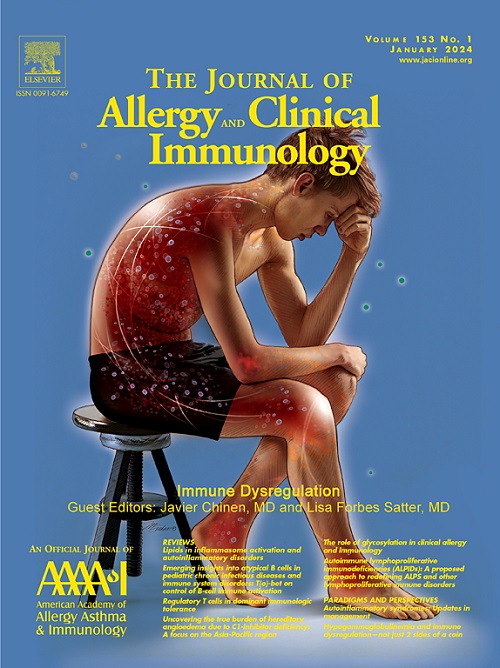慢性鼻窦炎伴鼻息肉的分子模拟驱动自身免疫。
IF 11.4
1区 医学
Q1 ALLERGY
引用次数: 0
摘要
背景:慢性鼻窦炎伴鼻息肉(CRSwNP)的发病机制仍然是一个讨论的主题。尽管微生物感染和自身免疫都被认为是CRSwNP病理生物学的潜在贡献者,但由于对CRSwNP中体液免疫失调的了解有限,它们各自在疾病进展中的作用和复杂的相互作用仍不清楚。目的:为了加深我们对CRSwNP的理解,我们寻求在疾病环境中鉴定显性b细胞克隆靶向的精确体液抗原。方法:采用免疫球蛋白库测序方法鉴定CRSwNP组织中的优势b细胞克隆。这些免疫球蛋白克隆被重建为抗体,然后用于免疫沉淀和抗原阵列实验,对自身和外源抗原进行无假设的全局抗原谱分析。结果:从13例CRSwNP患者的分析中,从9例患者的显性b细胞克隆中重建了31种抗体。鉴定出7种新的蛋白自身抗原,其中5种为核酸结合蛋白,均与自身免疫性疾病相关。此外,还发现了9种微生物抗原,包括各种病毒、细菌和真菌。值得注意的是,两种抗体表现出双重反应性,同时识别微生物和人类蛋白质。例如,一种抗体针对巨细胞病毒、破伤风梭菌和人凝集素(PLEC),而另一种抗体通过分子模拟共享氨基酸同源性识别黑曲霉和人二氢脂酰胺s -乙酰转移酶(DLAT)。结论:我们的数据表明CRSwNP的病理生物学可能涉及自身反应性体液免疫,其中一部分病例可能表现出由微生物感染引发的分子模仿驱动的自身免疫特征。然而,这一假设需要进一步调查。本文章由计算机程序翻译,如有差异,请以英文原文为准。

Molecular mimicry-driven autoimmunity in chronic rhinosinusitis with nasal polyps
Background
The pathogenesis of chronic rhinosinusitis with nasal polyps (CRSwNP) remains a subject of discussion. Although both microbial infection and autoimmunity have been proposed as potential contributors to CRSwNP pathobiology, their respective roles and intricate interactions in disease progression remain unclear owing to the limited knowledge regarding dysregulated humoral immunity in CRSwNP.
Objective
To deepen understanding of CRSwNP, we sought to identify the precise humoral antigens targeted by dominant B-cell clones within the disease environments.
Methods
Immunoglobulin repertoire sequencing was performed to identify dominant B-cell clones in CRSwNP tissues. These immunoglobulin clones were reconstructed as antibodies, which were then used in immunoprecipitation and antigen array experiments for hypothesis-free global antigen profiling of autogenous and exogenous antigens.
Results
From analysis of 13 patients with CRSwNP, 31 antibodies were reconstructed from dominant B-cell clones identified in 9 patients. Seven novel protein autoantigens were identified, 5 of which were nucleic acid–binding proteins, and all were associated with autoimmune diseases. Additionally, 9 microbial antigens, including various viruses, bacteria, and fungi, were discovered. Notably, 2 antibodies demonstrated dual reactivity, simultaneously recognizing both microbial and human proteins. For example, 1 antibody targeted cytomegalovirus, Clostridium tetani, and human PLEC, whereas another recognized Aspergillus niger and human DLAT, through molecular mimicry of shared amino acid homologies.
Conclusion
Our data indicate the possibility that the pathobiology of CRSwNP involves autoreactive humoral immunity, with a subset of cases potentially exhibiting molecular mimicry–driven autoimmune features triggered by microbial infections. Nevertheless, this hypothesis requires further investigation.
求助全文
通过发布文献求助,成功后即可免费获取论文全文。
去求助
来源期刊
CiteScore
25.90
自引率
7.70%
发文量
1302
审稿时长
38 days
期刊介绍:
The Journal of Allergy and Clinical Immunology is a prestigious publication that features groundbreaking research in the fields of Allergy, Asthma, and Immunology. This influential journal publishes high-impact research papers that explore various topics, including asthma, food allergy, allergic rhinitis, atopic dermatitis, primary immune deficiencies, occupational and environmental allergy, and other allergic and immunologic diseases. The articles not only report on clinical trials and mechanistic studies but also provide insights into novel therapies, underlying mechanisms, and important discoveries that contribute to our understanding of these diseases. By sharing this valuable information, the journal aims to enhance the diagnosis and management of patients in the future.

 求助内容:
求助内容: 应助结果提醒方式:
应助结果提醒方式:


